11 data-backed tips to increase your email open rate
 Jhonatan, customer support
Jhonatan, customer support
There’s lots of advice out there about how to increase email open rates. But what actually makes an impact?
For this article, we dug deep into our data to discover the key points that lead to more opens.
Here are 3 highlights of what we found:
Top-performing subject lines were 45% more likely to be between 20 and 40 characters than bottom-performing ones.
The most opened campaigns were 27.52% more likely to use subscriber filters than bottom-performing ones
Top-performing campaigns were 22.58% more likely to include a custom preheader than the bottom-performing ones.
But that’s not all! The data included plenty more insights and tips to help you get more eyes on your emails. Read on to discover what works!
First up, what’s a good email open rate?
In a previous study, we found that the median open rate for MailerLite accounts in 2024 was 42.35%. This varied significantly by industry, from travel and transportation, which had an email open rate of 22.57%, to religion, which had an open rate of 59.7%.
We’ve added some of the industry highlights in the table below. We’ve also included benchmark click-through rates (CTR), click-to-open rates and unsubscribe rates. You can also check the complete guide to email marketing benchmarks for more industries.
| Industry | Open rate | Click rate | Unsubscribe rate |
|---|---|---|---|
| Author | 39.08% | 2.73% | 0.21% |
| Nonprofit | 53.21% | 3.25% | 0.00% |
| E-commerce | 31.08% | 1.19% | 0.13% |
| Artist | 51.35% | 3.24% | 0.09% |
| Online courses | 43.81% | 2.00% | 0.10% |
| Music and musicians | 46.20% | 2.58% | 0.09% |
| Business and finance | 43.26% | 1.63% | 0.03% |
| Media | 43.56% | 4.02% | 0.03% |
| Higher education | 45.37% | 2.80% | 0.02% |
| Coaching | 48.17% | 1.54% | 0.00% |
Bear in mind that these are just benchmarks. If your open rate is much higher or lower than this number, use your own metrics as a starting point and try to increase your open rate from there.
About the data we used for this article
We compared the characteristics of the 10,000 top-performing campaigns with those of the bottom 10,000 campaigns. Performance was based on open rate, and we only selected campaigns sent to over 1,000 subscribers.
We then looked for patterns that could highlight what makes a difference when it comes to getting people to open your emails.
We’ve complemented this new data with insights from our other articles and testing to show a complete overview of the factors that can impact open rate.
11 ways to increase email open rates
These are the 11 points that we found to impact open rates. They can be put into 2 categories: visible and non-visible factors.
Visible factors are those like your subject line and preheader, which can directly cause people to open your emails. Non-visible factors include things like who you're sending to, the deliverability of your email marketing provider, and how you segment your list or time your campaigns.
Our list contains a mix of each type of factor. Here they are!
1. Use a subject line between 20 and 40 characters

The most opened campaigns were 45% more likely to have a subject line between 20 and 40 characters than those in the bottom-performing data set.
Additionally, email subject lines in the bottom-performing data set were 27% more likely to be over 40 characters.
This suggests that, as many of us have always thought, the length of your subject can impact your open rate.
Why is subject line length important?
Mobile inbox apps like Gmail and Apple Mail tend to only show around 30 characters of a subject line. If a subject line is between 20 and 40 characters, the majority of the content will be shown on mobile, ensuring that people can see most of the message.
If your subject line is over 40 characters, it may have important content that isn’t displayed. Even if it’s a super compelling subject line, people simply won’t see it. Meanwhile, subject lines under 20 characters may not be long enough to provide real value.
2. Segment, group or filter subscribers
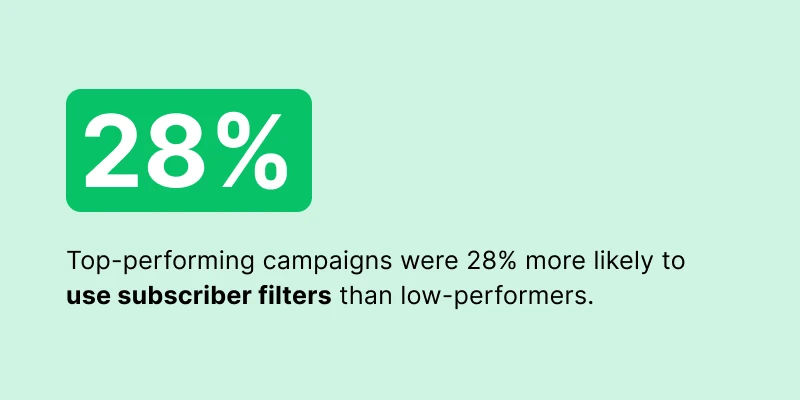
Top-performing email marketing campaigns were 28% more likely to use subscriber filters, such as sending to specific groups or segments, than the bottom-performing campaigns. This suggests that sending targeted emails is one of the best ways to increase your open rates.
This subscriber filter data also verifies the findings in our what works in e-commerce marketing report. The report found that emails with subscriber filters were 36.69% more likely to be opened than those without.
Why is segmentation important?
Emails with subscriber filters are typically more targeted than those without. Since the email is being sent to a specific target audience, the subject line and content can be tailored to appeal directly to the people receiving the email.
Here’s a simple example of how this can make an impact.
A sports e-commerce store sends a general top products email to its entire list.
The same store segments subscribers by the sport they are interested in and then sends the top products in each category to each segment.
The second set of emails is far more likely to perform than the first set since each person receives content they are interested in.
While it seems like creating multiple emails for each segment will be a pain, thanks to MailerLite features like email templates, AI content, reusable blocks and auto-populating e-commerce product blocks, you can put together separate emails for each group in a flash.
To group or segment subscribers you need to collect information about them and then use this data to create a group or segment. This could be demographic information or data on how they interact with your campaigns.
Here are some ways you can collect this data:
Ask in your opt-in form
Use surveys or quizzes
Use email interaction
Use e-commerce shopping data
Use data collected on signup like location
Use the signup method
Learn more in our ultimate guide to email segmentation.
3. Fill out your custom preheaders
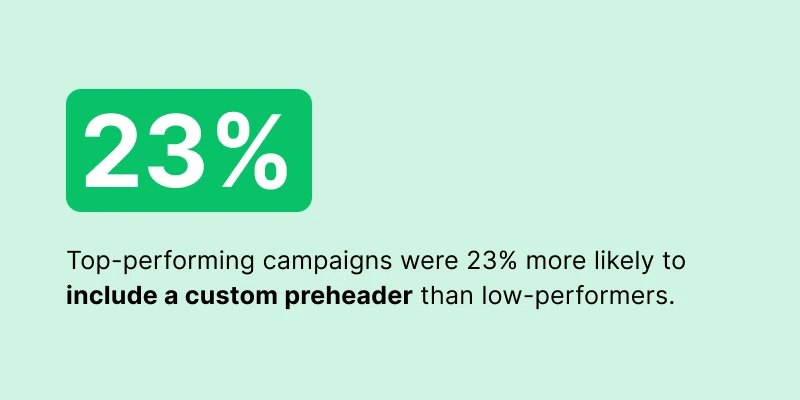
An email preheader is the text that you see next to the subject line on desktop inboxes or under the subject line on mobile inboxes. It’s an extra opportunity to highlight the value of your email.
Typically, inboxes automatically grab the email’s opening text and use this as the preheader text. But MailerLite lets you specify text to show in this section.
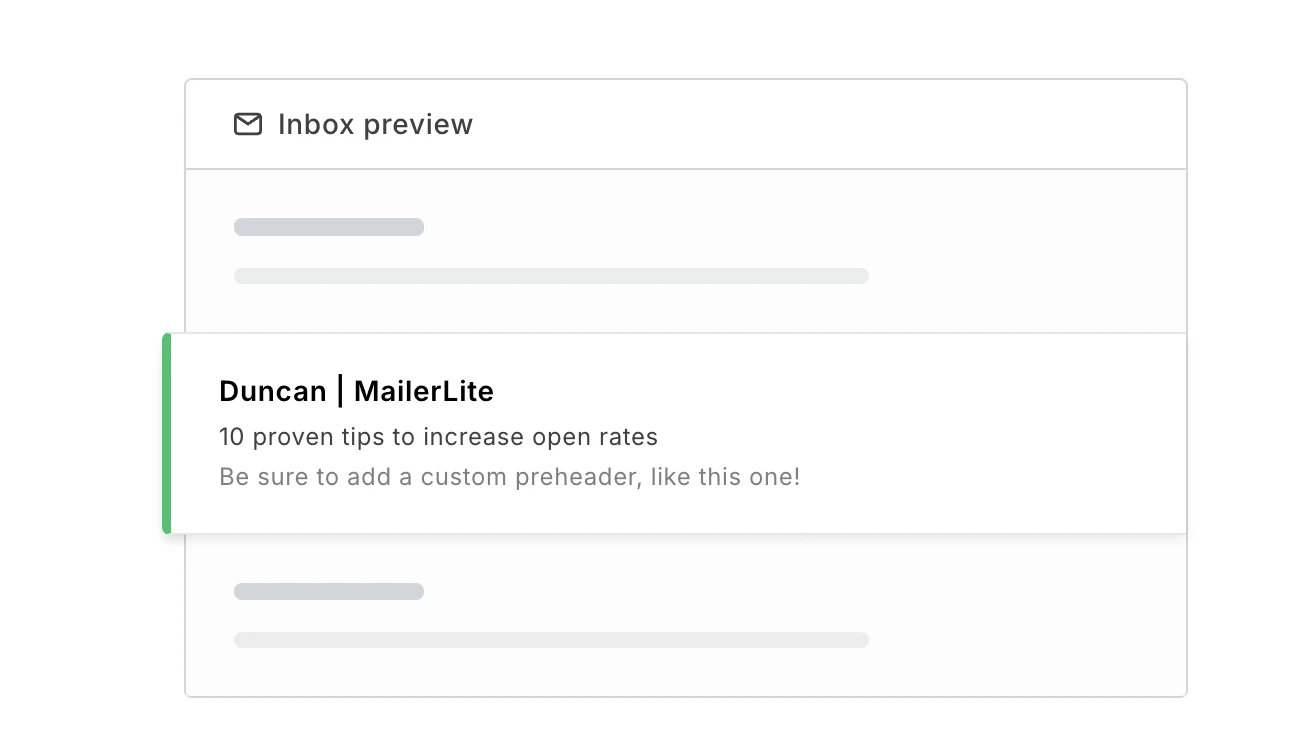
Our data suggests that taking the time to write your own preheader text can have a big impact on opens. Top-performing campaigns were 22.58% more likely to include a custom preheader than the bottom-performing ones.
Why are custom preheaders important?
While subject lines rightly get most of the attention, your email preheader is very visible in inboxes, making it a great opportunity to highlight the value of your message.
Taking the time to create a custom preheader is a good way to tell more people about your email content and give your open rate a boost.
4. Use an emoji in your subject line (when appropriate)
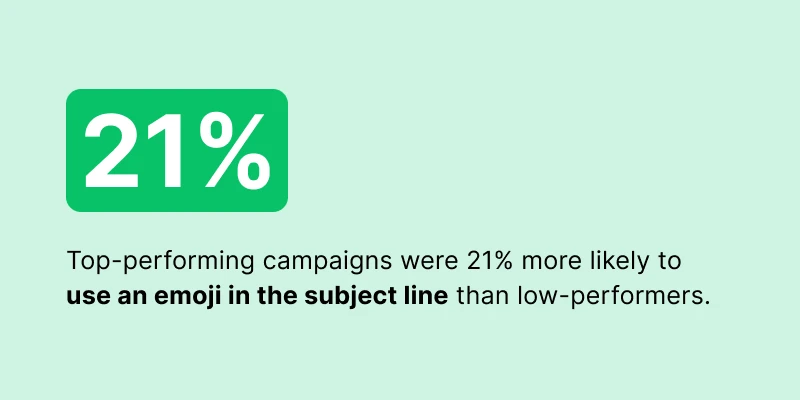
People love emojis, so it makes sense that using them in subject lines would increase open rates. Right?
Right! Our data shows that campaigns in the top-performing data set were 21% more likely to use an emoji in the subject line than those in the bottom-performing group.
Why are emojis important?
Since the majority of the inbox is black text on a plain background, colorful emojis stand out. Emojis also suggest that the content contained in the email will be fun and friendly, which could increase opens if your subscribers react to this kind of vibe.
Be aware that the impact of emojis on open rates will depend on your business and audience. They might not be suitable for businesses like law firms or consultancies with a more serious brand persona.
If you’re unsure how your audience will react, consider running an A/B test where one version of your subject line has an emoji and one doesn’t.
We did this and discovered that our audience reacts well to emojis. Now we use them often.
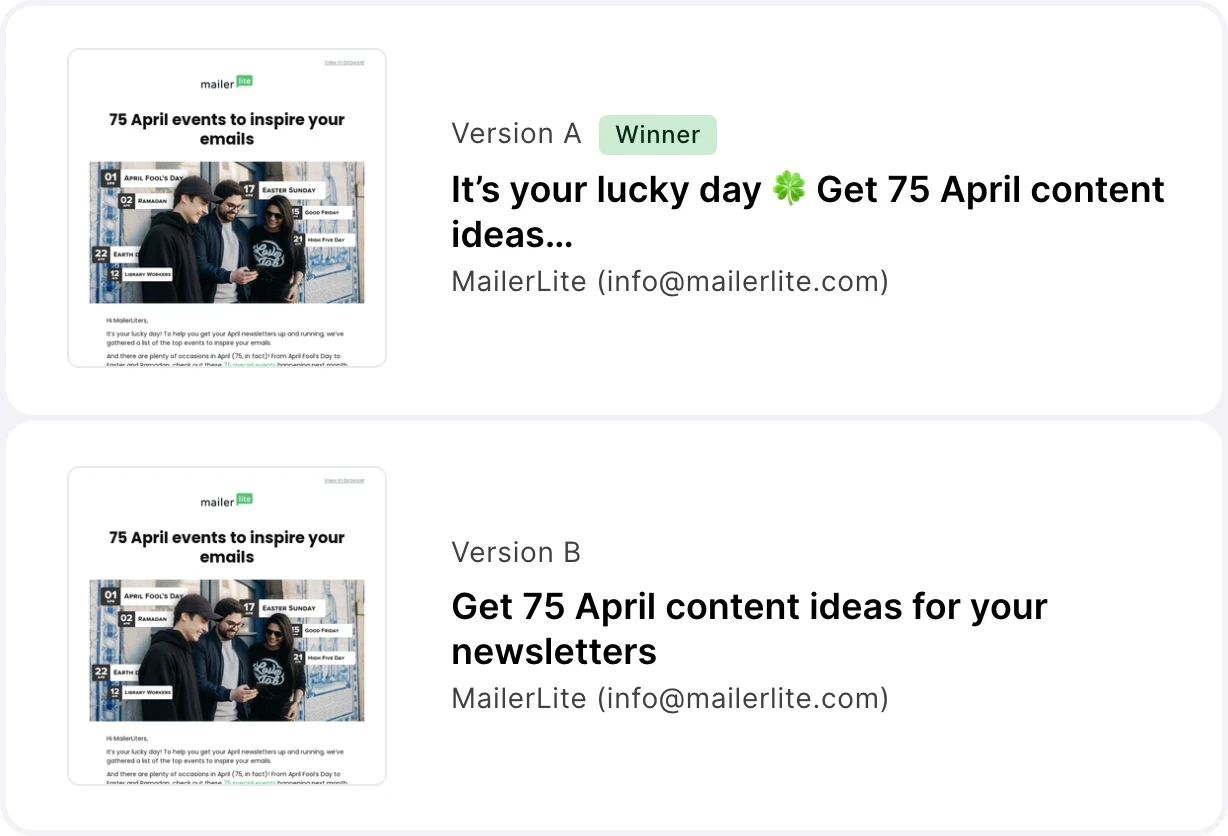
If you don’t want to run your own test, click here to see our data on how using emojis in your subject line could impact open rates for your industry.
5. Use a personal sender name
Alongside your subject line and preheader, your sender name is the other big thing email recipients see in the inbox.
Many email marketers think that using a personal name rather than or alongside a business name can increase opens, as it makes the message seem more personal.
We weren’t able to compare the open rates of using personal names in our sample dataset. But we did run our own sender name A/B test to see whether using a personal name makes a difference.
For one of our product newsletters, we tested using the name Kerry @ MailerLite vs. just using MailerLite.
The results were quite conclusive. The version of the email that used the personal name had a 3.81% higher open rate than the version with just a business name. Over 1,000 more people opened the version with the personal name.
Why is using a personal name important?
People may like to receive emails from people rather than businesses. Using a real sender name may cause an increase in opens by making your email seem friendly.
If you use this strategy, ensure the content matches this style. You can even use a personal sign-off at the end.
MailerLite has plenty of templates you can use to quickly add a signature and profile image to your emails. Save the block as a template and then drag it into any of your messages in a click so you don’t have to recreate the block each time you hit send.
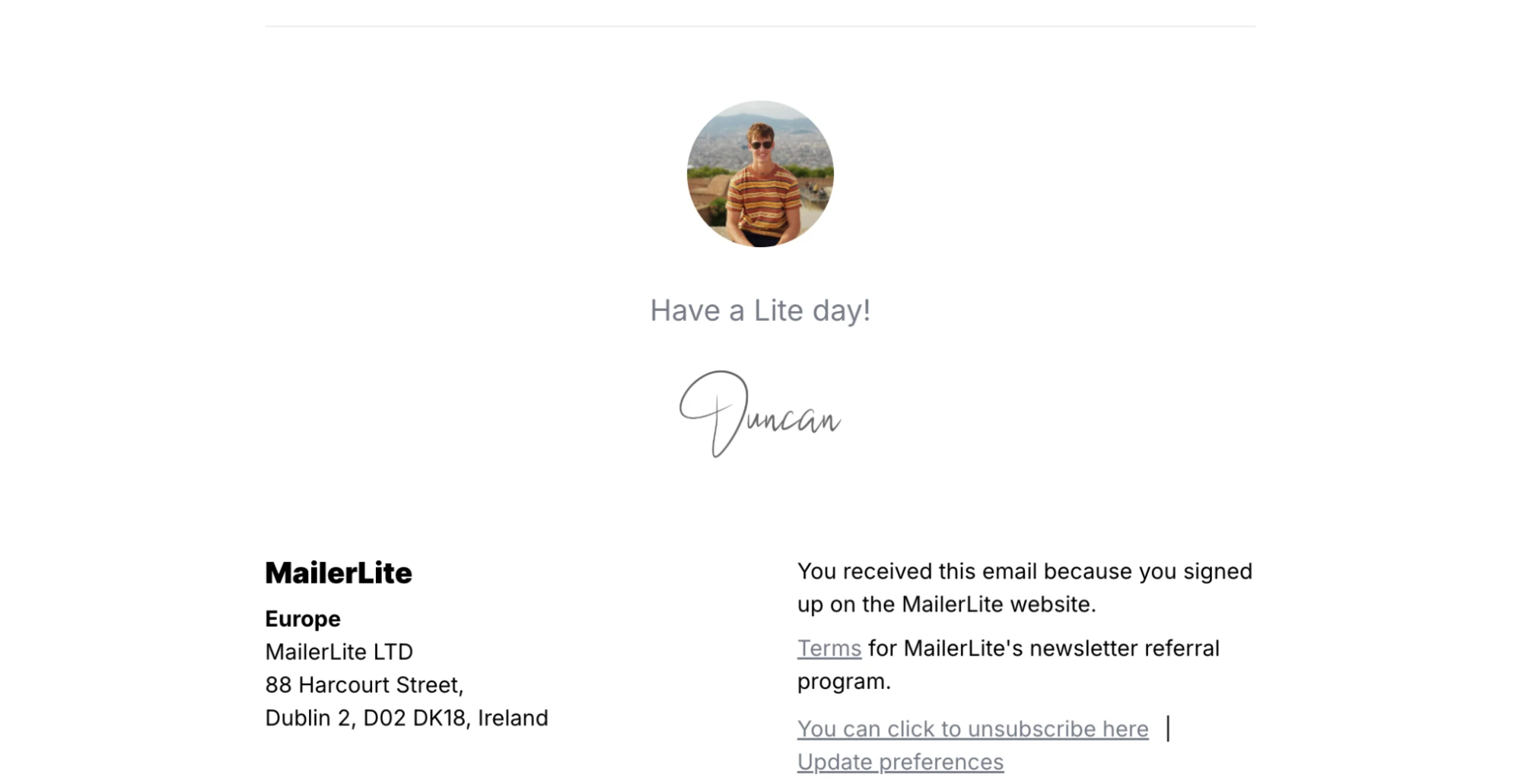
6. Send your emails at the right time
We recently looked into whether the time you send an email can impact its open rate. The study found that the highest engagement fell between 3 PM and 7 PM local time.
This was consistent for every day of the week except weekends, when the best time of day to send was 7 AM on Saturday and 9 AM on Sunday.
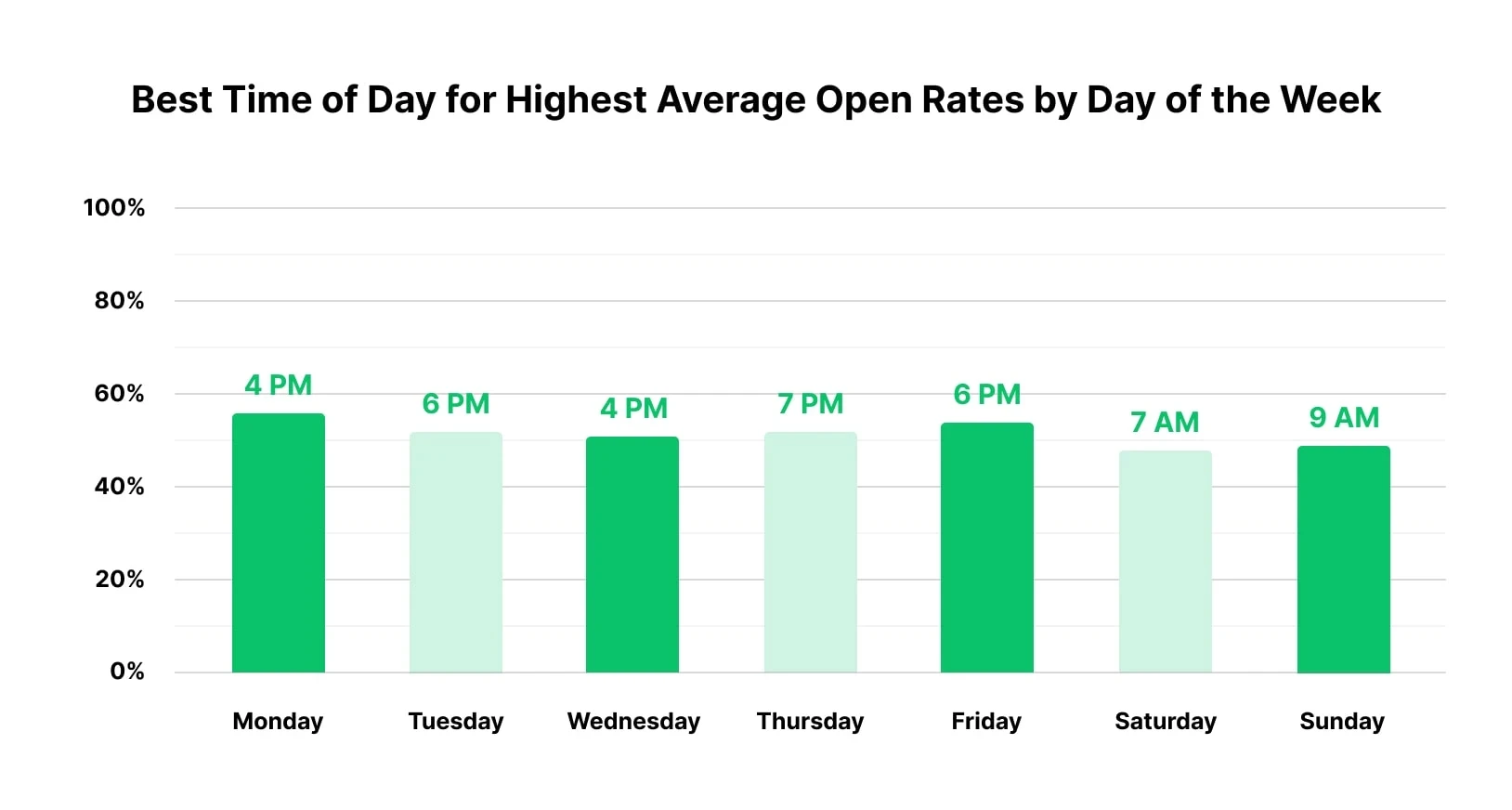
As for the best day to send, Sunday and Monday had the highest open rate, although the number stayed consistent throughout the week.
Why is send time important?
We don’t know exactly why people like to open their emails in the afternoon and evening. Perhaps people like to focus on deep work during the morning and then open their promotional emails and newsletters when things start to calm down during the late afternoon and evening.
As with everything in this article, we’d recommend testing the different sending times for your audience to find the one that works best.
Plus, you can always use tools like Send by time zone, which sends your campaign at the same time in each time zone, or Smart sending, which uses past subscriber behavior to predict the best time to send your emails to each subscriber.
7. Consider using automation
Automated emails go out when triggered without your input. A common example is a welcome email sent to new subscribers when they join your list. When we analyzed e-commerce emails, we found that automated emails vastly outperformed campaigns when it came to open rates.
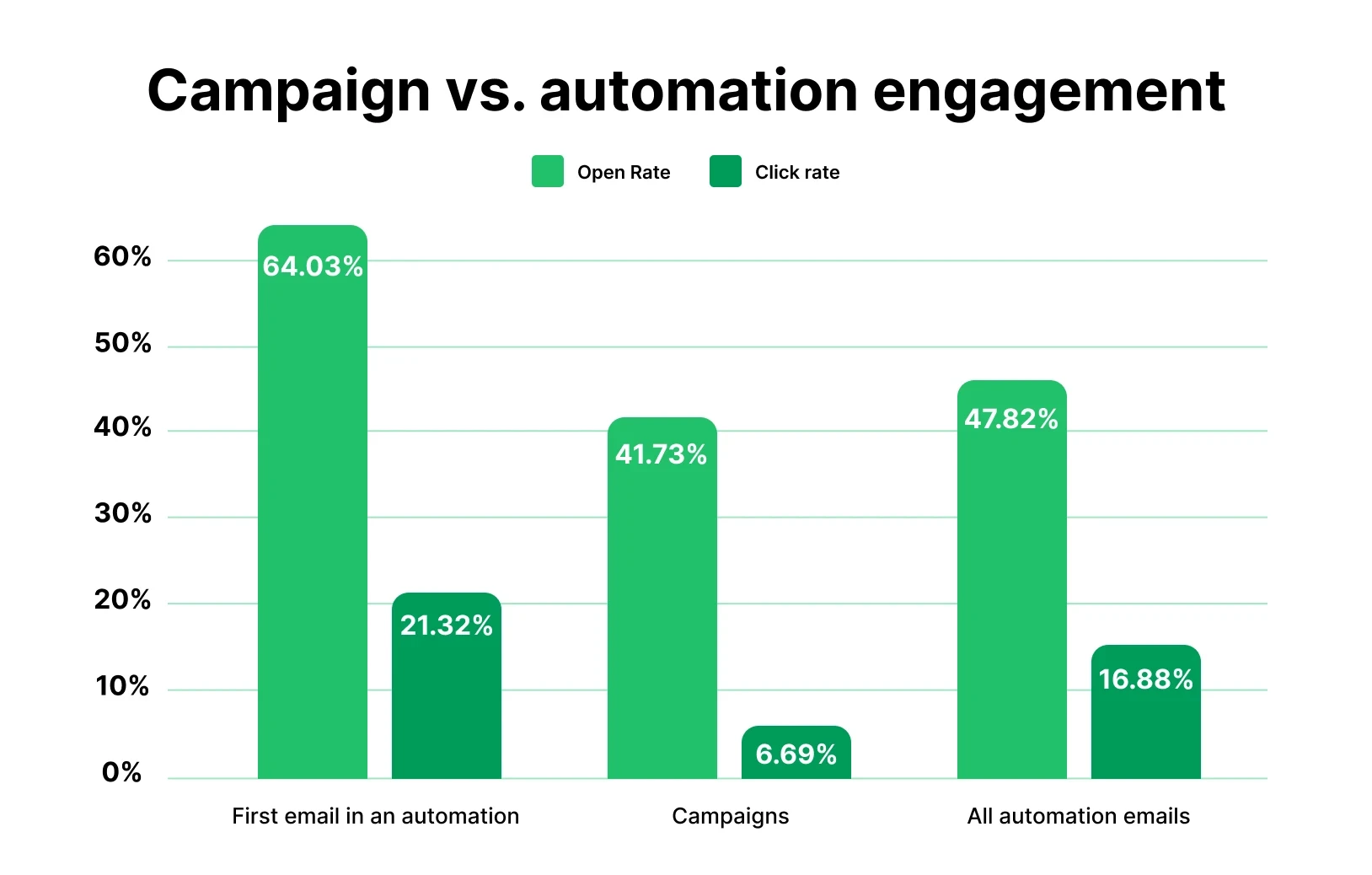
When we zoomed in specifically on the initial email in an automation, the difference was even greater. The first email in an automation had an open rate that was 53.43% higher than the average campaign.
Why is automation important?
Since they are triggered by a specific action taken by a subscriber, automated emails go out at the exact time people need them.
People want the content and are often expecting to be contacted, so it’s no surprise that automated emails have very high open rates.
While this won’t help with your regular newsletters, it’s worth thinking about whether there are types of content you send that would work better in marketing automations than campaigns.
You may end up with better engagement and a big time saving since you won’t have to send out the content manually.
8. Experiment with your email cadence
Email cadence is how often you send an email to your subscribers. Our data shows that how frequently you send emails can impact your open rate.
Accounts that send emails between once a month and twice a week had very similar open rates, while the open rate of those that sent daily emails was a little lower.
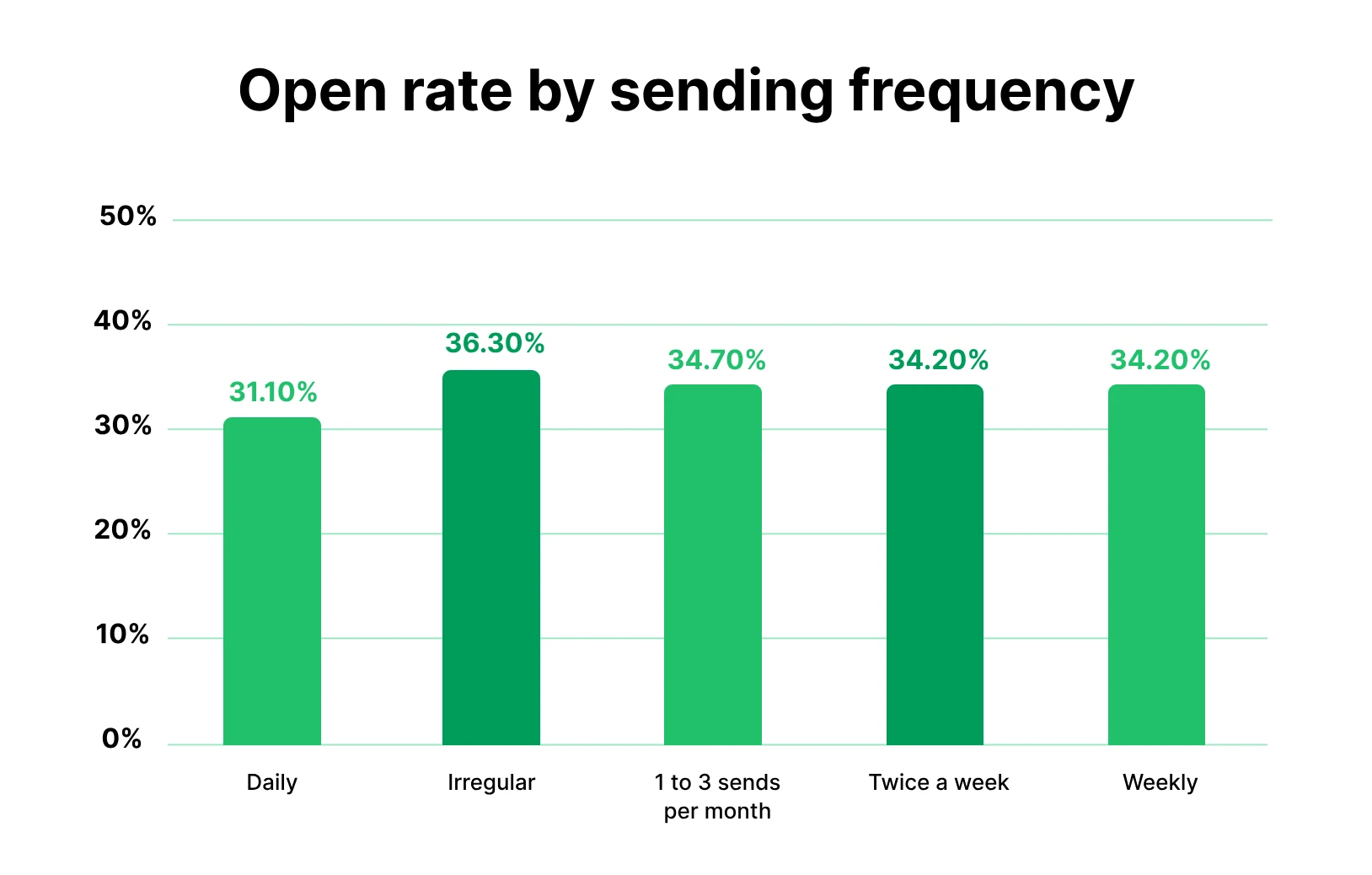
Accounts that sent infrequent emails had the highest open rates, although this was counteracted by higher unsubscribe rates and lower click rates.
Why is email cadence important?
Email cadence impacts open rates because it directly affects how your audience perceives and engages with your messages. If you send emails too often, subscribers may feel overwhelmed and tune out, resulting in a low open rate.
That’s why it’s important to find a cadence that works for you. Test, track, and optimize the number of emails you send until you hit the right rhythm.
Read more about our email cadence study and tips for finding the best one for you in our guide to finding the right email cadence.
9. Remove your inactive subscribers
The easiest way to increase your open rate is to remove people who don’t open your emails.
While you’re not actually increasing the number of people who open your emails, removing inactive subscribers will improve open rates by decreasing the percentage of your list who ignore your messages. Plus, you'll increase email deliverability and potentially decrease your email marketing costs.
Why is removing inactive subscribers important?
It’s simple: When you remove people who don’t interact with your emails, the percentage of people who do will increase.
With MailerLite, you can easily identify subscribers who aren’t opening or clicking on your emails with our Clean up inactive tab, which you can find in the Subscribers section of your dashboard.
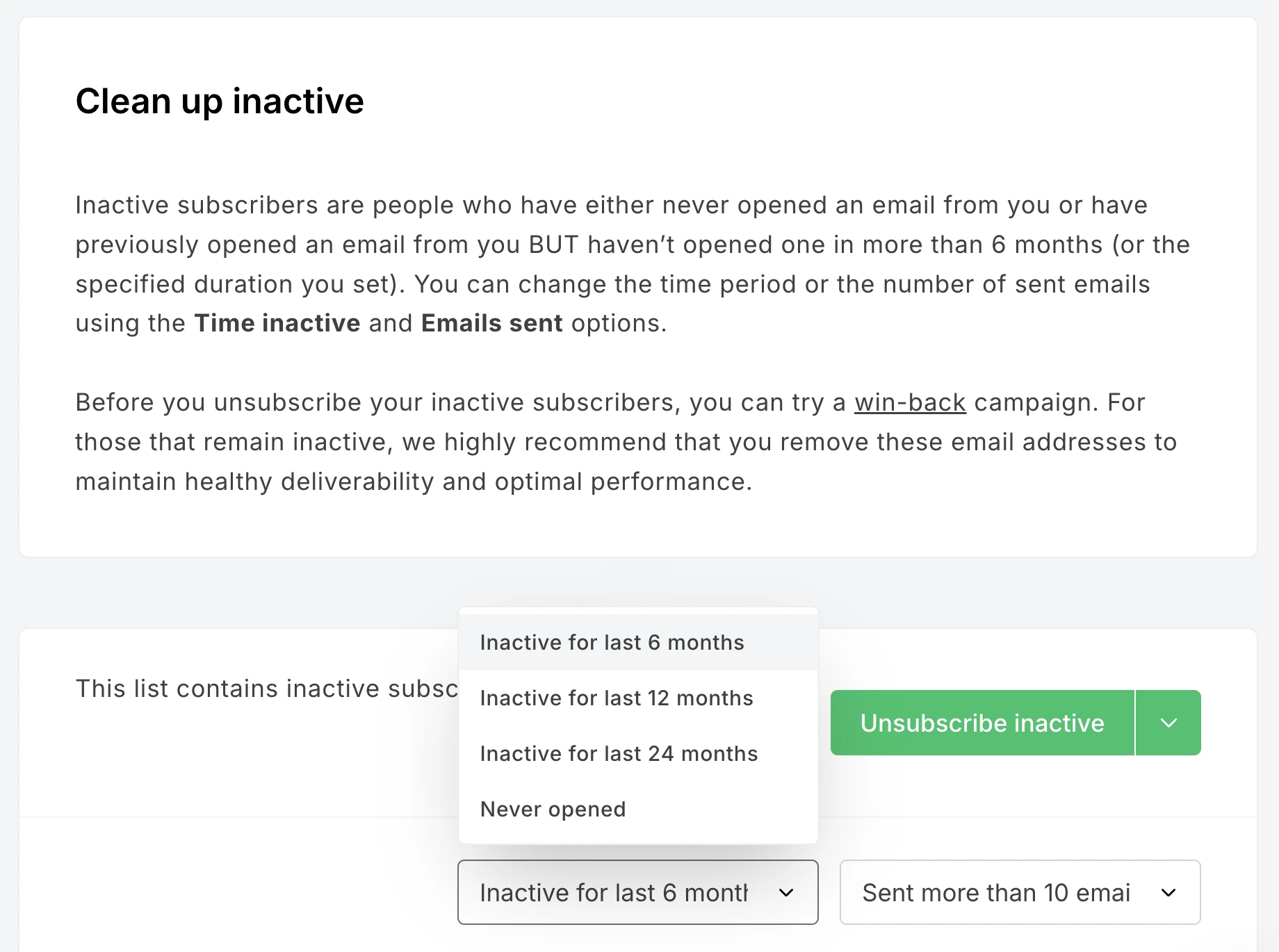
Just decide whether you want to remove those who have been active for 6, 12 or 18 months and then hit the unsubscribe button.
You could also consider sending a re-engagement campaign first to give inactive subscribers a final chance to interact with your content. Discover how to create a winning re-engagement campaign here.
Getting caught out by the spam filter will kill your email open rates. Here are some ways to boost your sender reputation and ensure your messages land in the inbox.
Use an email service provider (ESP) with a good reputation
Set up and authenticate your domain
Avoid using content that can trigger spam filters
Don’t purchase email lists
Learn more about these tips and more in this article on avoiding spam filters.
10. Use resend to unopened
Resend to unopened is a MailerLite feature that lets you resend a version of your email to people who didn’t open the first one.
This feature won’t increase the open rate of the initial campaign, but it will give people who didn’t open the first email another chance to see your content. This means the total percentage of people on your email list who see the email will be higher than if you just sent it once.
Why is resending to unopened important?
You’re simply giving people who missed your message another chance to interact with your content.
When e-commerce store Biovie uses the feature they typically get around 45% more opens compared to if they just send a single email. This means thousands more people seeing the brand’s content.
The automatic resend feature brings a lot of extra opens. We have around a 25% open rate on the first send and around a 15% open rate on the second.
A word of caution: don’t use this feature on every send. Sending 2 emails risks clogging up people’s inboxes with your messages. Instead, use it for your most important messages, such as product releases or big sales.
There are 2 ways to use the feature. The first is to set up an Auto-resend campaign, where you set up the follow-up message at the same time as the initial campaign. The whole process will be automated according to your settings.
The second option is to click on the campaign you want to resend, and then choose the option Resend to non-openers. You can then follow the steps to set up the campaign.
11. Send content people want to open
No amount of testing and tweaking will help if people don’t like your content. Fortunately, you don’t have to guess at what people want, there are plenty of ways to see what resonates.
Here are some of the things we do at MailerLite to check we’re sending content people like.
Keep track of email marketing metrics and KPIs like open rate and click rate to see which topics, offers, or messaging get the most engagement
Use A/B testing to test 2 different subject lines or types of email content to see what gets the most clicks or opens
Track how different topics perform on other channels like social media, and use the learnings in your email marketing
Check the conversion rates of different offers or calls to action to see what causes people to take action
Simply ask! Use an email survey to ask your audience what they want to hear about
With this insight available, you’ll be able to tailor your content and message around the interests of your subscriber list, which will boost not only opens but also the overall impact of your campaigns.
You’ve increased your open rate! What next?
Increasing open rates is an important first step in your email marketing strategy. But once someone opens your message, it’s important that it then continues to push them towards your goals.
Learn how to do this in our guides to the email marketing funnel, creating effective calls to action (CTA), and boosting your conversion rates.
Boost your open rate with MailerLite
Join MailerLite to access open rate-boosting features like segmentation, send by timezone, custom preheaders, and more. Plus, we have leading email deliverability to ensure your messages hit the inbox.
